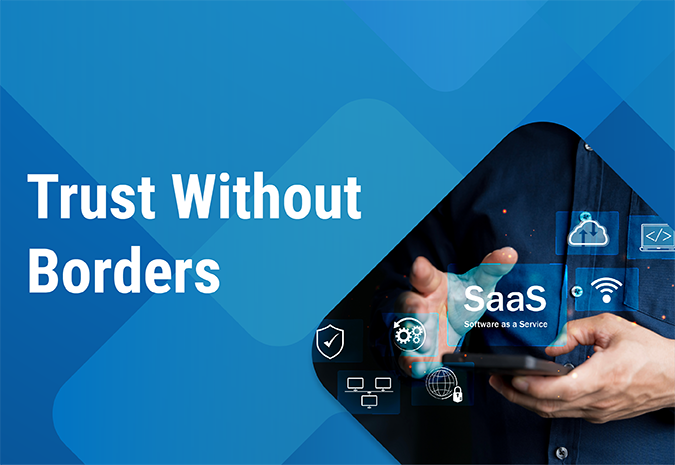
What happens when your network has no edge?
That’s the reality for most organizations today. Employees work from anywhere, cloud platforms handle sensitive data, and SaaS applications touch every layer of the business.
But many security models still assume a fixed perimeter, and that’s where risk creeps in. Building digital trust means rethinking how—and where—your business enforces security.
Why perimeters aren’t the protection they used to be
Once, security meant locking down the network perimeter—guarding the edge with firewalls, VPNs, and tightly controlled physical access. But that perimeter no longer exists. Employees access systems from coffee shops, business applications live in the cloud, and sensitive data moves across multiple environments. The modern enterprise is decentralized, and its security model needs to catch up.
Key drivers of perimeter erosion include:
- BYOD and mobile device usage: Employees use personal laptops, phones, and tablets to access corporate resources—devices that often fall outside of centralized IT control.
- SaaS adoption and hybrid workforces: Core business functions now run on cloud-based platforms. Teams collaborate across time zones and networks, often without ever touching the corporate LAN.
- Cloud infrastructure displacing data centers: Traditional data centers are giving way to cloud environments where infrastructure is virtual, elastic, and often managed by third parties—far beyond the reach of legacy perimeter defenses.
These trends are reshaping how and where organizations need to establish trust—no longer at the edge, but everywhere connections are being made.
What is digital trust?
Digital trust is the confidence that users, partners, and customers place in your organization’s ability to secure data, systems, and interactions—consistently and at scale. It’s built on a foundation of strong identity, encryption, and access controls, but it also reflects how well those controls are implemented across modern environments.
In today’s cloud-first, perimeterless world, digital trust must extend across operating systems, cloud platforms, Software as a Service (SaaS) tools, and connected devices. It depends not only on the strength of your security measures but also on their consistency, transparency, and ease of use. A system that’s secure but brittle, or one that protects data but breaks user workflows, ultimately undermines trust. Real digital trust is resilient, user-friendly, and architected to scale with the evolving digital landscape.
Building trust in a perimeterless age
Securing your digital environment requires more than tools—it takes a shift in mindset. As perimeters dissolve, organizations need to build trust into the fabric of their infrastructure. That means designing systems where authentication, encryption, and visibility aren’t bolted on but instead built in from the start. It also means moving beyond manual processes and fragmented controls to a unified, automated approach that adapts to evolving threats.
Here are four ways leading organizations are putting that into practice.
1. Identity and access at the center
The zero-trust model assumes no connection is inherently safe—every user, device, and system must be authenticated and continuously verified. Implementing certificate-based authentication and multi-factor access control helps ensure that only authorized identities gain entry, no matter where they connect from.
2. PKI as a foundational layer
Public key infrastructure (PKI) is essential for establishing identity and encrypting sensitive data. In a perimeterless world, PKI extends trust across devices, applications, and users—whether in a data center or in the cloud. It’s the backbone for secure communication in distributed environments.
3. Automation across the lifecycle
Manually managing certificates and configurations isn’t just inefficient—it’s risky. Automation enables organizations to enforce policy consistently, eliminate human error, and respond faster to renewals, revocations, or compromises. It also frees up teams to focus on strategic security improvements.
4. Resilience through crypto-agility
With quantum computing on the horizon, future-ready organizations are already preparing for the shift to post-quantum cryptography (PQC). A crypto-agile infrastructure makes it possible to adopt new algorithms quickly and at scale—without disrupting operations or rebuilding core systems.
What business leaders need to know
For business leaders, digital trust isn’t just a technical concern—it’s a strategic driver. When trust is embedded into core business systems, organizations can move faster, adopt new technologies with confidence, and protect their brand reputation in an increasingly connected world.
In a recent survey, we asked global organizations how they view trust as part of their security and operational strategies. The results were clear: Companies that prioritize digital trust report fewer security incidents, stronger customer loyalty, and greater agility in adopting new cloud services and emerging technologies.
Trust enables growth. Without it, compliance burdens grow, and over time, customer confidence erodes.
A roadmap to building digital trust
Here’s how to get started:
- Assess current trust levels: Where do different levels of trust exist across your systems?
- Map dependencies: Know which core business systems, operating systems, and SaaS platforms need better integration.
- Evaluate partners: Work with vendors like DigiCert that offer crypto-agility, PKI integration, and global scalability.
Looking to modernize your approach? DigiCert helps organizations implement digital trust frameworks that are scalable, future-ready, and built for the demands of a perimeterless world. Get in touch to learn how we can help you take the first step toward building trust into every layer of your infrastructure.
The latest developments in digital trust
Want to learn more about topics like digital trust, crypto-agility, and PKI? Subscribe to the DigiCert blog to ensure you never miss a story.





